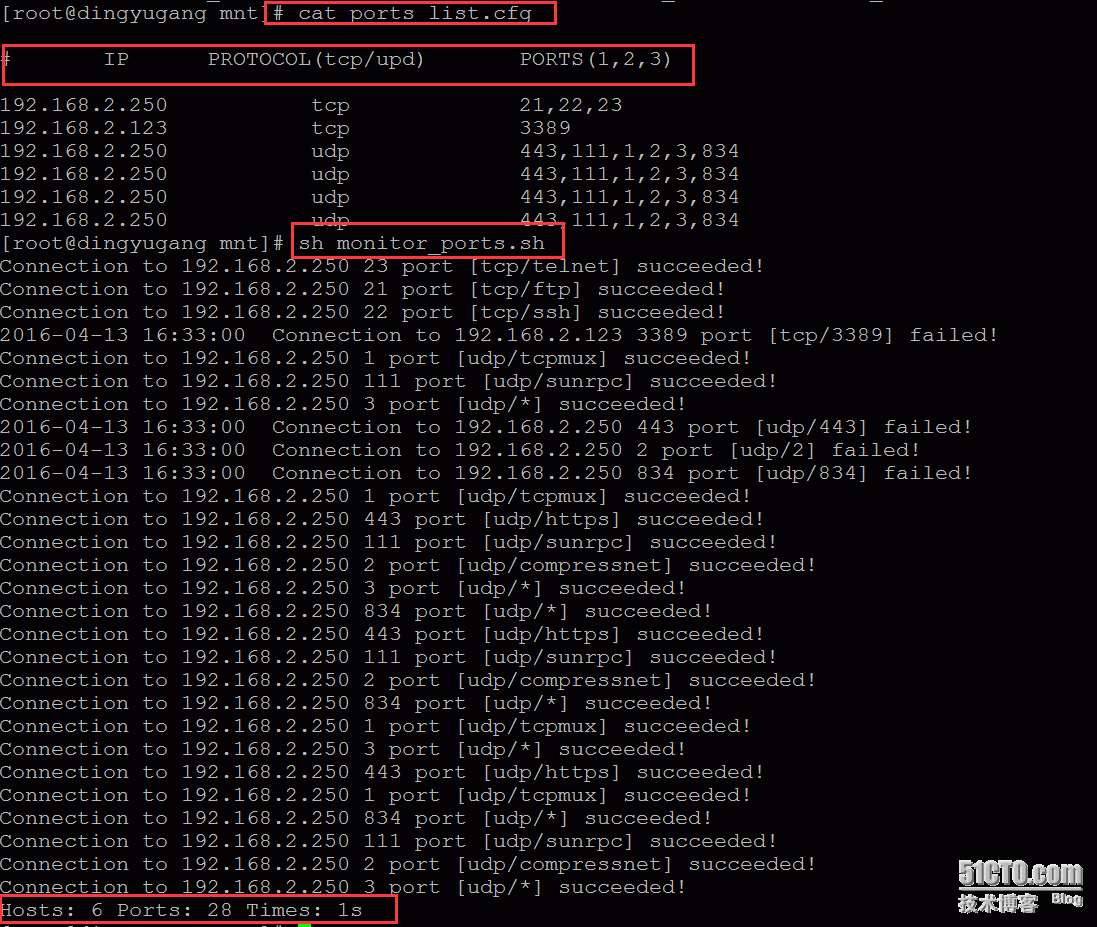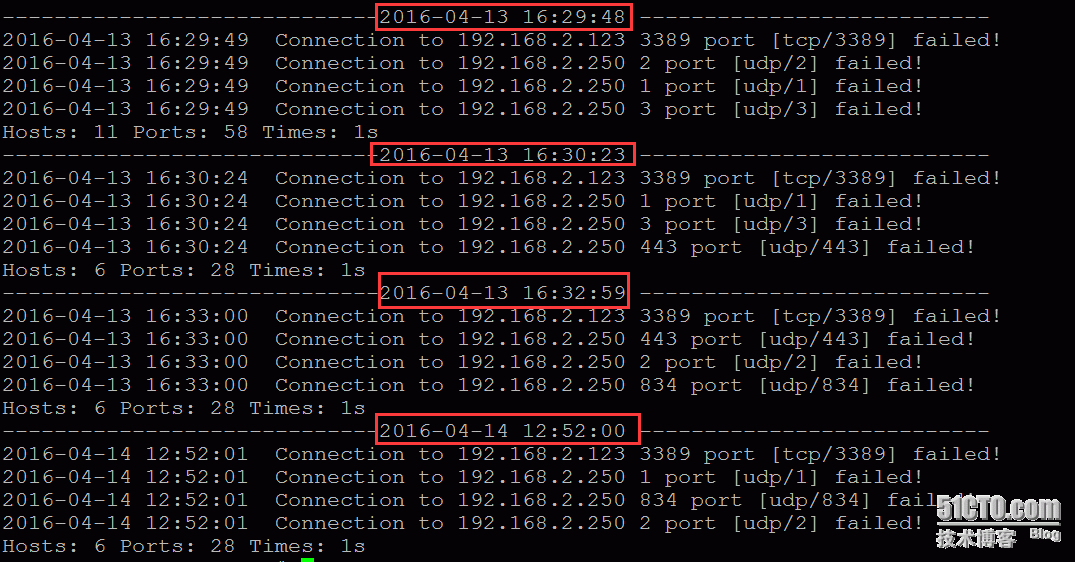脚本应用之四: 批量端口扫描
2016-04-13 16:28
337 查看
作用:批量端口扫描,可根据扫描主机的配置调整后台扫描进程数量(手动执行后根据统计的执行时间调整脚本中关于进程数量的参数),通过定时任务作为简单的服务监控(可修改脚本添加其他报警功能,例如邮件等)
实现:使用nc指令扫描端口, 使用管道特性控制后台扫描进程数量
不足:仅仅对扫描端口状态为down的信息做记录,并没有其他报警操作
使用:需要提供包含被扫描主机的ip地址、协议和端口号的配置文件(格式见演示或代码专区注释)
需要一个日志文件记录端口down状态信息。
配置和日志文件在脚本中定义,默认为:ports_list.cfg 和 port_down.log
演示:

每扫描一次会在日志文件中做记录

代码专区:
代码下载链接
本文出自 “逆行者” 博客,请务必保留此出处http://lingyi.blog.51cto.com/2837715/1763482
实现:使用nc指令扫描端口, 使用管道特性控制后台扫描进程数量
不足:仅仅对扫描端口状态为down的信息做记录,并没有其他报警操作
使用:需要提供包含被扫描主机的ip地址、协议和端口号的配置文件(格式见演示或代码专区注释)
需要一个日志文件记录端口down状态信息。
配置和日志文件在脚本中定义,默认为:ports_list.cfg 和 port_down.log
演示:

每扫描一次会在日志文件中做记录

代码专区:
#!/bin/bash
# LY
# ------------------
# Copyright 2016.4.14, LingYi (lydygly@163.com) QQ:1519952564
# "scan ports"
#the conf_file, like this:
#------------------------------------------------------
# IP PROTOCOL(tcp/upd) PORTS(1,2,3) |
# |
# 192.168.2.250 tcp 21,22,23 |
#------------------------------------------------------
#配置文件,根据情况修改
conf_file=ports_list.cfg
port_down_log=port_down.log
#后台扫描进程数量,根据服务器配置调整
number_of_background_processes=1000
host_count=0
port_count=0
time_start=0
time_end=0
all_cfg_infor=$( grep -E -v '(^ *#|^$)' $conf_file )
#check nc
if ! rpm -q nc &>/dev/null; then
yum install -y nc &>/dev/null
[[ $? -ne 0 ]] && exit 1
fi
#打印信息
function timestamp()
{
echo -n "$(date +"%Y-%m-%d %H:%M:%S") "
}
#扫描端口函数
# host {tcp|udp} port
function scan_host_port()
{
local this_protocol
if [[ $2 == 'udp' ]]; then
this_protocol='-u'
else
this_protocol=''
fi
if ! nc -z -w 1 $this_protocol $1 $3; then
#其他报警等操作可在此出添加
echo "$(timestamp) Connection to $1 $3 port [$2/$3] failed!" | tee -a $port_down_log
fi
}
sum_line_of_all_cfg_infor=$(echo "$all_cfg_infor" | wc -l)
#管道操作
fifo_file=$(date +%s)
if mkfifo $fifo_file; then
exec 46<>$fifo_file
rm -fr $fifo_file
else
echo "Create fifo file failed !"
exit 2
fi
#每个echo对应一个管道输入,多少次输入就只能最大对应多少次输出,以此来达到控制后台进程数量的目的
#关于shell多进程,参考:http://lingyi.blog.51cto.com/2837715/1575730
time_start=$(date +%s)
for((count_n=1; count_n<=number_of_background_processes; count_n++))
do
echo >&46
done
echo -----------------------------$(timestamp)--------------------------- >>$port_down_log
for((line_num=1; line_num<=sum_line_of_all_cfg_infor; line_num++))
do
line_infor=$( echo "$all_cfg_infor" | sed -n "${line_num}p" )
line_ip=$( echo $line_infor | awk '{print $1}' )
line_protocol=$( echo $line_infor | awk '{print $2}' )
#read line_ip line_protocol < <(echo $line_infor | awk '{print $1,$2}')
for this_port in $( echo $line_infor | awk '{print $3}' | tr ',' ' ')
do
#每做一个端口扫描动作读取一次管道
read -u46
#将扫描进程放入后台,以实现进程并发
{
scan_host_port $line_ip $line_protocol $this_port
#操作完成之后,对管道做一次写入操作
echo >&46
} &
let port_count++
done
let host_count++
done
wait
#释放
exec 46>&-
exec 46<&-
time_end=$(date +%s)
echo Hosts: $host_count Ports: $port_count Times: $((time_end-time_start))s | tee -a $port_down_log代码下载链接
本文出自 “逆行者” 博客,请务必保留此出处http://lingyi.blog.51cto.com/2837715/1763482
相关文章推荐
- 使用PostBackUrl属性实现跨页面传值
- Android 带一键删除按钮的EditText
- 错误:-[UIKBBlurredKeyView candidateList]: unrecognized selector sent to instance
- android 自定义闪退Dialog 收集闪退信息
- 跟我一起学extjs5(08--自己定义菜单1)
- 小图标文字对齐的终极解决方案
- js--JSON
- iOS js oc相互调用(JavaScriptCore 1)
- HLS/MPEG-DASH/RTMP with nginx
- 入学登记系统
- linux vi退出操作
- Reveal高级技巧(越狱设备)
- angularJs入门第二篇:全局函数
- Reason: no suitable image found
- Unity 使用ShareSDK 3.X 版本发布Xcode进入AR闪退
- MYSQL 解锁与锁表
- ListView实例(SimpleAdapter实现)
- SlickEdit基本设置
- 在CMD下用java命令出现“找不到或无法加载主类”问题
- 使用Nginx抵御DDOS攻击
